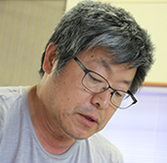May All Be Here Now - Suh Yongsun_curated by Kim Doyeon
Artist Suh Yongsun stands out in the field of historical painting, a genre that has been unprosperous in contemporary Korean art. He has been involved in a vast range of realms such as mythology, history, urban aspects, and politics while creating a large body of self-portraits that depict him looking straight ahead with an intense stare suggestive of a strong sense of identity. His persistent exploration of his own position and origin has expanded into an observation of urban scenes and the quotidian lives of others via his concerns with Korean mythology and history.
His cardinal works include a series that addresses the life history of King Danjong of Joseon who ascended the throne at the age of 12 but whose life was tragically ended by his uncle and a series of urban scenes dealing with his observations of contemporary people while traveling to numerous cities such as Seoul, Beijing, New York, and Berlin.In addition, he has shone an interest in stories that take place in a wide array of space-time in pieces and projects such as Mago(2009), a serialized work featuring Mago, a cosmogonic goddess in Korean creation myths who was believed to be the creator of the heavens and earth, Children(2014), a series capturing the faces of the victims of the Sewol ferry disaster, and the Cheolam Project, an art project that breathes a new life into an abandoned coal mine area and its local residents.
This exhibition consists of his self portraits and scenes of Masan that Suh observed while staying and working at the Masan Fruit and Vegetable Market Residency as its first resident artist. The peculiar thing is that the dates on which he executed his work are recorded chronologically on all of the canvases. The work dates are not references to the completion of his painting but records of scenes, highlighting the act of painting itself. He used to commit himself to facing the canvas after observing his objects. As such, his brushwork does not assume a supporting role for the completion of his work. Each brush stroke has a freestanding encounter with the canvas and was not made to represent an event. For this reason representation is not the goal of his painting. The artist leaves traces arising from a collision of an object with the flat surface of a canvas as well as remnants of his very private, intuitive encounter with the object. Viewers then follow and chase such traces as if investigating the scene of the event. To Suh, painting is not only the realm of possibility, but a currently living story.
His work The Man Who Paints (2016) featuring the artist himself as he paints his self-portrait demonstrates his self-awareness through his own individual act of painting. Suh’s art style is particularly meaningful in that he displays a special interest in those who have been gradually marginalized through his constant act of painting, almost as if he is keeping a diary. As it is unlikely that he will cease to explore himself in the future, we will one day view the world from a perspective that will be inspired by another reality he raises on his canvas.















